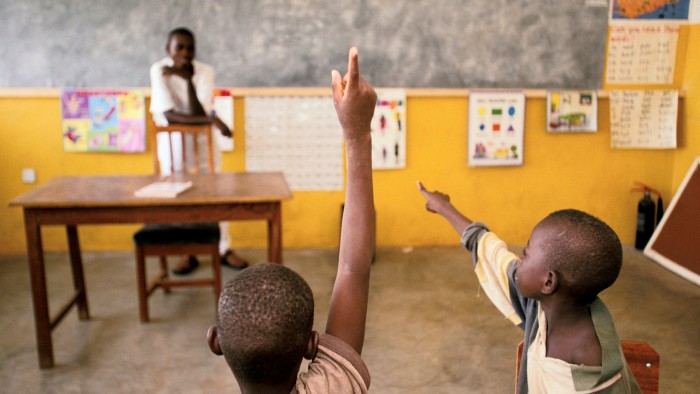Social impact bonds boost literacy and numeracy but can they scale?

Roula Khalaf, Editor of the FT, selects her favourite stories in this weekly newsletter.
A year ago most children in Jyoti Bala’s class in Paharpur in north-eastern India had never seen a laptop. But by the time coronavirus struck, they were seasoned users of her primary school’s new computer laboratory, using software to improve their maths and reading skills.
“They can adapt more swiftly than in the big classroom, and I can see where a child is lagging, help resolve their problems and then teach those topics in the class,” she says.
Ms Bala is part of a pioneering programme that uses private money to improve students’ literacy and numeracy in schools that are free to attend or charge low fees. It is backed by one of the growing number of innovative financial structures designed to generate funding from social impact investors, who receive a return linked to the project’s success.
It is a decade since the UK unveiled the world’s first “social impact bond”, intended to help reduce criminal reoffending. Since then, dozens of other bonds covering various themes have appeared in multiple countries. Initiatives targeting the provision of education in lower income nations have started to become a new focus.
To their supporters, social impact bonds are a way to expand funding from the private and non-profit sectors to improve education through incentives and greater accountability. To their critics, they are a costly distraction and risk undermining approaches led by the public sector.
Educate Girls, the first such bond, was issued in 2015 and focused on Rajasthan in north-west India. Ms Bala is a beneficiary of the second initiative of this type, the Quality Education India Development Impact Bond, which was launched in 2018, the same year that South Africa began its Early Childhood Impact Development Bond.
Now the World Bank plans programmes in Pakistan and Uzbekistan, and the Education Outcomes Fund, hosted by Unicef, the UN agency for children, has set a target to raise $1bn to underwrite impact bonds in lower-income countries. The first two bonds, in Ghana and Sierra Leone, could start as soon as next year.
While each bond is different, the common idea is that one or more providers bid for funding to improve the standard of education over a given period. If they achieve or exceed targets, they and their impact investor backers receive a bonus.
“We are doing something new and innovative that requires a big mindset shift,” says Amel Karboul, chief executive of the Education Outcomes Fund. “The aim is to deliver results that are transformational for social change, paying for success when achieved and creating space for private investors to jump in.”

Systems that pay for successful results have grown in popularity and these are normally backed by international development donors, usually governments and philanthropists. Impact bonds offer the chance to increase the range of funders to those seeking a financial return.
“Impact investing will evolve in a similar way to venture capital in kicking off the high-tech industry,” says Ronald Cohen, the veteran venture capitalist and an architect of social finance, who has written a book on the topic. “I wouldn’t be surprised if paying for success raises $1tn. The idea can spread much more widely and it will grow because it delivers much better results per pound spent.”
“Impact bonds are increasingly interesting because they are focused on outcomes and come at a time when the environment is so uncertain for philanthropy,” says Phyllis Costanza, head of philanthropy at UBS, who runs the bank’s Optimus Foundation behind the two Indian initiatives. “We have found our clients who are involved in finance are really interested.”
Judged on their own terms, the initial projects show promise. Educate Girls, which had a budget of $275,000 and reached 7,300 children in 140 villages, reported on completion in 2018 that learning levels for its students grew 79 per cent more than for their peers in other schools over three years. It said 768 eligible out-of-school girls returned to study, above its target of 662.
“A lot of funding to non-profits was tied to inputs rather than results,” says Safeena Husain, the organisation’s founder, who is seeking to finalise a fresh $100m fundraising to expand its approach to reach 1.5m out-of-school girls across India. “This was the first time in education we [used] a very results-based lens. Everybody said to me it can’t be done. But it can!”
The key to success, she concludes, is offering flexible forms of supplementary education, deploying village-based volunteers to persuade families to send their girls to school.
Ms Bala’s school uses a computer-assisted learning system developed by Mindspark, one of four providers supported by the Development Impact Bond. An interim evaluation this year across the 100,000 children it has supported in more than 600 Indian schools showed they were learning twice as fast as their peers in comparable schools. One underperforming provider has been dropped.
Not everyone is convinced of the value of impact bonds, however. One concern is their narrow focus on aspects that are easy to measure. Another worry is that they will encourage gaming to reach targets.
“A focus on indicators for which we have relatively better measures ignores more complicated, longer term, softer objectives such as generational change and citizenship engagement,” says Prachi Srivastava, associate professor of education at Western university in Canada. “I’m not sure you can generate true social outcomes in three years.”
But Abha Thorat-Shah, executive director of social finance at British Asian Trust, a backer of the India bond, says: “If you don’t focus on anything, you don’t do anything. If you have generic aims of doing good in 15 areas, at the end you don’t know if anything happened.” She adds that the support which investors offer to providers helps foster the flexibility and support to succeed.
David Edwards, general secretary of Education International, a network of teachers’ unions, raises a second set of objections. He warns that a mechanism that draws in private sector investors seeking financial returns risks diverting resources from government programmes, while undermining democratic accountability and teachers’ authority and rights.
Others argue that the complexity and high costs of structuring impact bonds may outweigh the benefits, particularly since most investors have been philanthropic organisations that used to be more focused on social outcomes than financial returns — and they could have supported the providers directly.
Emily Gustafsson-Wright from the Center for Universal Education at the Brookings Institution think-tank, who has analysed impact bonds, says there are some grounds for hope but the trade-offs are hard to judge in the absence of more data on costs and the relative benefits compared with alternative financing mechanisms.
While impact bonds may be growing, the big question is whether they will lead to systemic reform in particular countries: they require additional funding and management skills to scale up.
“The big challenge is whether programmes will be able to maintain efficiency gains as they move towards regular streams of funding,” says Avnish Gungadurdoss, managing partner of Instiglio, a consultancy that has been pivotal in launching impact bonds.
“One can’t help feel a bit disappointed [that] the idea has not been taken up more” he says. “The biggest challenge is getting governments interested in their adoption.”
Comments